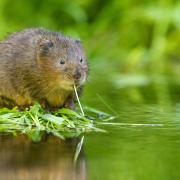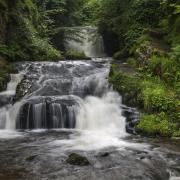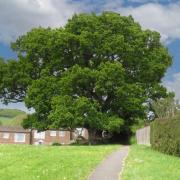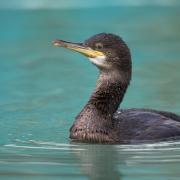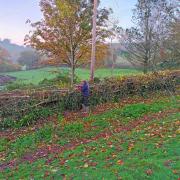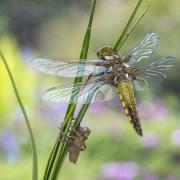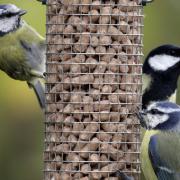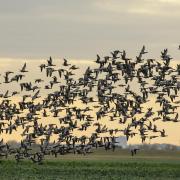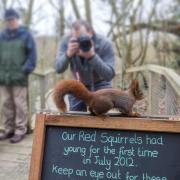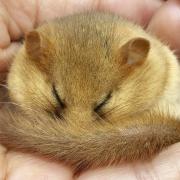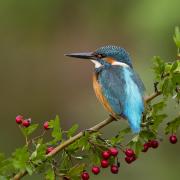Struggling species, crafty cuckoos and smelly shrubs are all part of Tom Rhys Williams’ May wildlife checklist, but keep your eyes peeled as they are quite elusive this month!

The month of May gives a most welcome headache when it comes to selecting my ‘top 5’ wildlife picks. How does one begin to select just five species when the Devon countryside is bristling with life? The dawn chorus is reaching a crescendo. Birds are courting and those that aren’t are incubating eggs or feeding young. Flowers are bursting from buds filling the air with perfume and delighting the eye with blues, pinks, yellows and whites. Also appearing are the leaves from ash trees that always bring up the rear when it comes to ‘leafing up.’ The air is full of insects and, down below, mammals tend to their young. It is an absolute joy to be outdoors. Forgive my omissions, there are many, but here are five to look out for in May.
Hawthorn (May)
To coin an old sporting cliché, this plant was the first name on the team sheet! The reason being is that an alternative old English name for this plant is simply ‘May’. Named so because May is the month where this tree grabs your attention with a mass of musty fragrant cream blossom. If you were to close your eyes and walk slowly along a hedgerow on a warm May evening, you would know when you were below a hawthorn such is the scent. It’s a thick powerful smell that I enjoy but others have likened it to the smell of decaying flesh! It seems a little extreme. Give it a sniff and see what you think. Due to this association with death, it has long been regarded as unlucky to bring the blossom into your house. As we become less connected with nature, old superstitions like this are falling by the way side.
May Bug

The May bug is an animal that will always evoke strong memories of school. For a day or two each year when the conditions were just so, the playing field would be filled with these robust insects famed for mass flights. In turn there was terror and shrieks from girls running for their very lives. As far as beetles go they have very nice little faces with fluffy antennae. Their casing looks like an upturned rowing boat where the varnished wood looks tatty and under loved. The beetles have tiny hooks on the end of their feet so if they land on you, they require a bit of a tug to remove them. I dare say it’s this last point that makes them so ‘terrifying’. Any animal that has multiple names is usually a species that had significance for people over the years. As well as May bugs they are cockchafers, doodlebugs, billy-witches and midsummer dors. Before the use of pesticides, vast swarms of these beetles would take to the air in May. Eggs laid in the soil gave rise to larvae that lived in the soil feeding on root crops amongst other things; hence the near eradication of yet another species.
Cuckoo
Most of us will already know one or two facts about this legend of the bird world. The call needs no introduction although the first two notes from a half-hearted wood pigeon can be mistaken for a cuckoo. A real cuckoo call has greater bass and authority and it’s cleaner. Once you hear the real thing, a pigeon will never catch you out again. The bird is just as famous for its nesting habits as its call. The sight of a tiny reed warbler or meadow pipit feeding a chick far bigger than itself is one of the strangest in nature. The cuckoo is mind bogglingly brilliant. How does the female cuckoo produce an egg that mimics the host’s so perfectly? How does the little chick know how to push all the other eggs out the nest? Sadly more and more effort or luck is required to enjoy the ‘Cuc-koo’. They are a species very much on the decline. We are losing habitat in the UK but the mass killing of songbirds in Malta will not be helping matters. If you are lucky enough to hear one, treasure the experience. In coming years the cuckoos may fail to return.
Cuckoo Flower

Some species are named after the cuckoo just as others are named after the month of May. It’s as though the bird is on equal pegging with the month itself. We have a cuckoo flower, cuckoo pint (a small lily) and ‘cuckoo spit’ which is the white froth a tiny frog-hopper makes around itself for protection. Cuckoo flowers are a delicate pale pink. They are relatively tall amongst the young grasses in the meadows or road verges standing a few inches proud. Orange-tip butterflies seek them out for nectar but also to lay their eggs. The caterpillars go on to feed on the edible peppery leaves. It’s also said that this is a favourite flower of the fairies, so, (you’ve guessed it) it’s unlucky to bring it into your house.
Violet oil beetle
This beetle is an absolute whopper. Even bigger than the May bug. It has a small head and thorax that seems to pull along a huge abdomen. With its relative size and shape it reminds me of an articulated truck. If you see a huge black beetle in May that matches this description, you have likely found an oil beetle. The name appears misleading at a glance but much like the dark feathers of a starling or magpie, when the beetle catches the light just right, there is an iridescent shine and violet appears as if from no where. The beetle has a fascinating life cycle. The female will lay eggs underground. The larvae, on hatching, will then seek out flowers that will be visited by mining bees. The larvae have small hooks on their legs and as the bee visits the flower, they hook on, hitching a lift back to the bee’s nest. Once here, they feed on the eggs, pollen and nectar acting as a nest parasite. The female beetles like to burrow on bare ground so footpaths are great areas to spot them. Be kind to them. They are harmless and pretty rare.
Tom Williams is a naturalist living on the north Devon coast just outside of Barnstaple. When he’s not working as a veterinary surgeon, he’s exploring the stunning Devon countryside on his doorstep.




